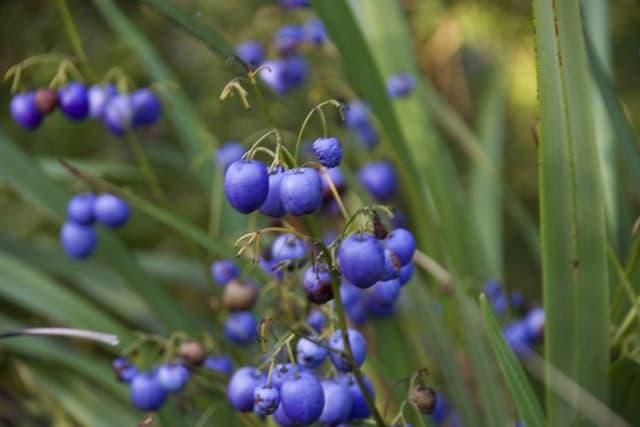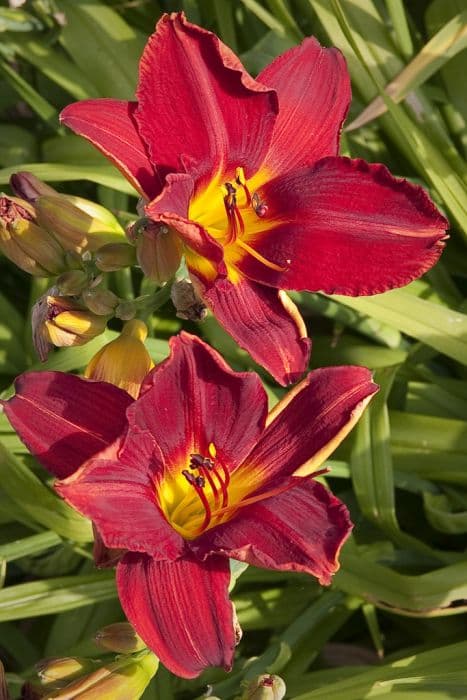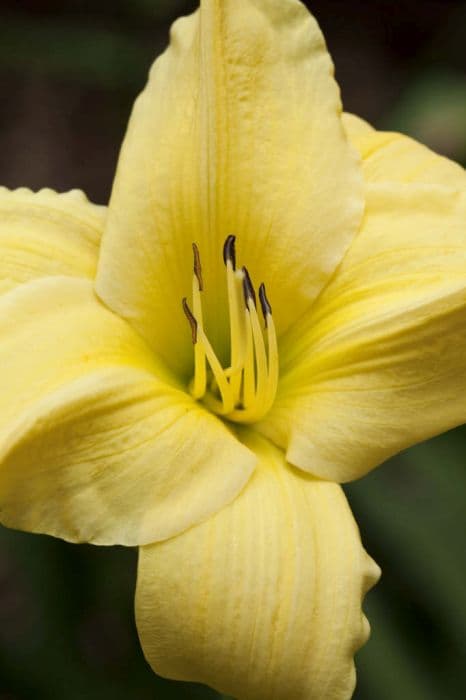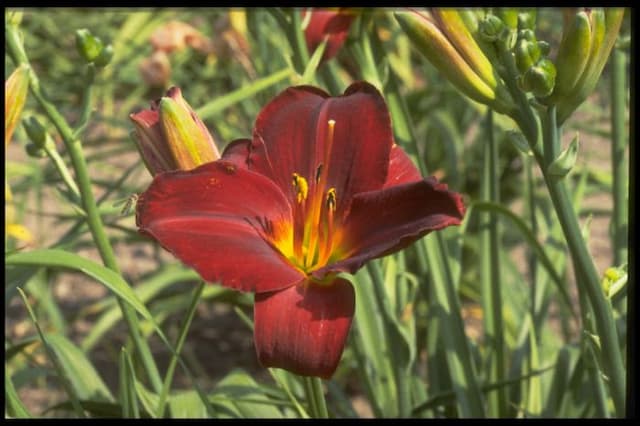Daylily Hemerocallis 'Golden Chimes'

ABOUT
The daylily 'Golden Chimes' is a striking perennial that boasts a vibrant display of flowers. This plant is characterized by its luscious, trumpet-shaped blooms that come in a rich golden-yellow hue, which exudes a sense of warmth and cheeriness. Each flower comprises six petal-like segments, with the petals gently ruffling at the edges, giving them a delicate and inviting appearance. The heart of the flowers typically features a slightly deeper yellow or even a greenish-yellow throat, providing an eye-catching contrast to the bright petals. The blossoms are borne atop slender, sturdy stalks that emerge from clumps of arching, narrow, strap-like foliage. The leaves are a lush green color, which form a dense and grassy tuft, serving as an elegant backdrop to the radiant blooms. 'Daylily' is a fitting common name because each flower typically lasts only one day, opening up in the morning and withering by the following night. However, the plant produces an abundance of buds, ensuring a continuous succession of flowers throughout the blooming period. The daylily 'Golden Chimes' does not only convey beauty but also a sense of transience and renewal as each day brings forth new blooms to admire.
About this plant
 Names
NamesSynonyms
Daylily, Common Daylily, Tawny Daylily, Ditch Lily.
Common names
Hemerocallis 'Golden Chimes'
 Toxicity
ToxicityTo humans
The plant commonly known as daylily (Hemerocallis 'Golden Chimes') is not considered toxic to humans. In fact, some species of daylily are edible and have been used in culinary applications in various cultures. However, it's important to note that not all daylilies are edible, and it is advised to use caution and proper identification before consuming any plant. Generally, ingestion of daylilies by humans does not result in poisoning or notable symptoms.
To pets
The plant commonly known as daylily is considered toxic to cats. Ingesting any part of this plant can cause symptoms of poisoning in cats, which can include vomiting, lethargy, kidney failure, and in severe cases, death. If a cat ingests any part of a daylily, it is urgent to seek veterinary care immediately. While the daylily is particularly toxic to cats, it does not appear to have the same level of toxicity to dogs and other pets. However, it's still advisable to prevent all pets from ingesting this plant to avoid any potential health issues.
 Characteristics
CharacteristicsLife cycle
Perennials
Foliage type
Deciduous
Color of leaves
Green
Flower color
Yellow
Height
1 feet 6 inches (46 cm)
Spread
1 feet 6 inches (46 cm)
Plant type
Herb
Hardiness zones
3
Native area
Asia
Benefits
 General Benefits
General Benefits- Easy to grow: Hemerocallis 'Golden Chimes', commonly known as Daylily, is well-regarded for its hardiness and ease of cultivation, making it a great choice for novice gardeners.
- Drought tolerance: Daylilies are known for their ability to withstand periods of drought once they are established, reducing the need for constant watering.
- Long blooming period: This variety of Daylily offers an extended blooming time, which can provide color and interest in the garden for much of the summer season.
- Attracts pollinators: The vibrant flowers attract bees, butterflies, and other beneficial pollinators, promoting a healthy and diverse garden ecosystem.
- Versatile garden use: Daylilies are versatile plants that can be used in borders, flower beds, and as ground cover, providing an array of landscaping possibilities.
- Low maintenance: Daylilies require minimal care, which makes them a convenient choice for gardeners who have limited time or prefer low-maintenance gardens.
- Rapid growth and spreading: With their ability to multiply and spread, Daylilies can quickly fill in garden spaces, making them effective at preventing weed growth.
- Variety of conditions: Daylilies can thrive in a range of soil types and different levels of sunlight, from full sun to partial shade, allowing them to be planted in various locations in the garden.
 Medical Properties
Medical PropertiesThis plant is not used for medical purposes.
 Air-purifying Qualities
Air-purifying QualitiesThis plant is not specifically known for air purifying qualities.
 Other Uses
Other Uses- Edible Flowers: The blooms of the daylily 'Golden Chimes' are edible and can be used in salads, as a garnish, or even in desserts for a mild, sweet flavor and a splash of vibrant color.
- Natural Fabric Dye: The petals of 'Golden Chimes' can be used to create a natural yellow dye for fabrics, providing a safe and eco-friendly coloring option for textile enthusiasts.
- Crafting Projects: The sturdy flower stalks and spent blooms can be used in crafting projects such as wreaths, dried flower arrangements, or potpourri.
- Garden Borders: This daylily variety can be planted along the edges of garden beds to provide a neat border that helps to define the space and prevent soil erosion.
- Companion Planting: Due to their hardiness, daylilies can be planted alongside vegetables and other flowers to fill in gaps, provide ground cover, and suppress weeds.
- Water Garden Accent: While not an aquatic plant, 'Golden Chimes' can be grown near water features to add an eye-catching pop of color and vertical interest.
- Fish Pond Habitat: Planting daylilies like 'Golden Chimes' around the edge of a fish pond can provide shade and shelter for fish and other aquatic creatures.
- Floral Art: The individual daylily flowers can be used in floral art projects, including Ikebana, the Japanese art of flower arrangement.
- Erosion Control: Their root systems help stabilize soil, making them ideal for planting on slopes or areas prone to erosion.
- Photography: The striking appearance of 'Golden Chimes' creates a perfect subject for garden photography, drawing the interest of both amateur and professional photographers.
Interesting Facts
 Feng Shui
Feng ShuiThe Daylily is not used in Feng Shui practice.
 Zodiac Sign Compitability
Zodiac Sign CompitabilityThe Daylily is not used in astrology practice.
 Plant Symbolism
Plant Symbolism- Beauty and Pride: The daylily, Hemerocallis 'Golden Chimes', with its striking golden color, is often associated with beauty and a sense of pride. Its vivid flowers can represent the inner beauty and self-confidence of a person.
- Transience and Renewal: Since each bloom typically lasts for just a day, daylilies symbolize the fleeting nature of life. This characteristic can also suggest a theme of renewal and the idea that each new day brings fresh opportunities.
- Motherhood: In Chinese culture, daylilies are a symbol of motherhood and fertility. They are often associated with the nurturing aspects and the devotion of mothers.
- Forgetfulness and Loss: The name Hemerocallis comes from the Greek words for “day” and “beautiful,” alluding to the flower’s brief lifespan. This has led to its use in funerals or when remembering the deceased, as it can symbolize the ephemeral nature of life and memory.
 Water
WaterDaylilies, like Hemerocallis 'Golden Chimes', generally prefer consistently moist soil, so it is important to water them regularly, especially during their active growing season in spring and summer. They should be watered deeply about once a week, providing about one inch of water each time which equates to approximately 0.6 gallons per square foot. Adjust watering based on rainfall, more in times of drought and less when there is sufficient rainfall. It is crucial to water early in the morning to reduce evaporation and help prevent disease. Ensure that the water reaches the roots where it is needed most and avoid overhead watering to keep the foliage dry and prevent fungal diseases.
 Light
LightDaylilies thrive in full sun to partial shade, requiring at least six hours of sunlight a day to perform best. Hemerocallis 'Golden Chimes' will bloom most prolifically in a spot that receives morning sunlight and some afternoon shade, especially in hotter regions. Avoid deep shade as this will significantly reduce the number of flowers.
 Temperature
TemperatureDaylilies are quite adaptable and can tolerate a range of temperatures. Hemerocallis 'Golden Chimes' can survive in temperatures as low as 20°F but may stop growing. For ideal growth, maintain a temperature range between 50°F and 90°F. Avoid exposing the plant to extreme heat without adequate water as it might stress the plant.
 Pruning
PruningDaylilies require minimal pruning. Deadheading Hemerocallis 'Golden Chimes' by removing spent blooms regularly will encourage more flowers. In late fall or early spring, prune back any dead foliage to tidy the plant and promote healthy new growth. The best time for heavy pruning is after flowering has finished in late summer or early fall.
 Cleaning
CleaningAs needed
 Soil
SoilDaylilies (Hemerocallis 'Golden Chimes') thrive best in well-draining soil amended with organic matter such as compost or peat moss. The ideal soil mix for daylilies should consist of a mixture of two parts loam, one part peat moss or compost, and one part sand or perlite to ensure good drainage. The preferred soil pH for daylilies should be slightly acidic to neutral, ranging from 6.0 to 7.0.
 Repotting
RepottingDaylilies (Hemerocallis 'Golden Chimes') typically do not require frequent repotting as they are perennial plants that are often grown outdoors in the ground. In containers, repot every 3-4 years or when the plant outgrows its pot, usually in early spring or after the flowering season.
 Humidity & Misting
Humidity & MistingDaylilies (Hemerocallis 'Golden Chimes') are fairly tolerant of a range of humidity levels and do not require specific humidity conditions, as they are adaptable to the typical outdoor environment where they thrive best.
 Suitable locations
Suitable locationsIndoor
Provide bright light, well-draining soil, infrequent watering.
Outdoor
Plant in full sun to partial shade, in fertile, well-drained soil.
Hardiness zone
3-9 USDA.
 Life cycle
Life cycleThe life of a Daylily 'Golden Chimes' begins with seed germination, where the seed requires warmth and moisture to sprout roots and shoots. The young plant, or seedling, develops into a juvenile plant with characteristic long, strappy leaves and begins to establish a robust root system. As it matures, it forms a clump of foliage and an expanding root structure, entering a period of vegetative growth. Upon reaching maturity, it begins to produce flower stalks, each adorned with multiple buds that will bloom into the distinctive golden-yellow, trumpet-shaped flowers, typically in the early to mid-summer. After pollination, the flowers produce capsules filled with seeds, which can be dispersed to grow new plants. During the fall or under stress, the plant may enter a period of dormancy, where above-ground growth ceases, but the plant remains alive through its root system, ready to regrow in the following growing season.
 Propogation
PropogationPropogation time
Spring to early summer
Hemerocallis 'Golden Chimes', commonly known as Daylily, is often propagated by division, which is the most popular method. This process is typically done in early spring or late summer to early fall. To propagate by division, gardeners dig up the clump of the Daylily and gently separate it into smaller sections, each with a few fans of leaves and adequate root structure. These individual sections are then replanted at the same depth they were growing previously, spaced approximately 18 to 24 inches (45 to 60 centimeters) apart to allow for growth. Adequate watering after replanting helps establish the newly divided plants. This method of propagation allows the Daylily to rejuvenate and can help increase the number of plants in a garden or share with other gardeners.









